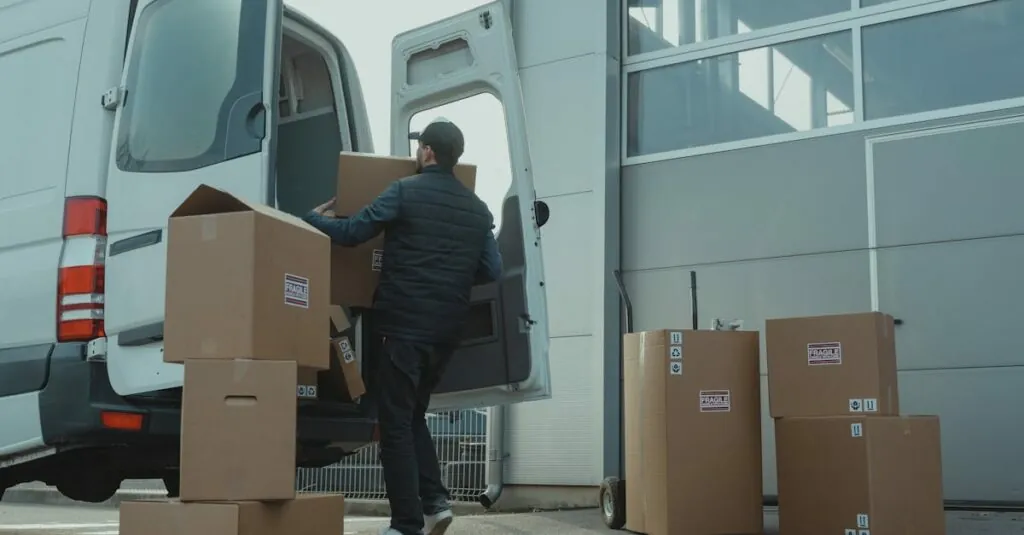Table of Contents
ToggleIn a world where online shopping reigns supreme, the delivery packaging score is the unsung hero of the e-commerce experience. It’s the secret sauce that can turn a simple purchase into a delightful surprise or a cardboard catastrophe. Imagine tearing open a box only to find your new gadget wrapped in enough plastic to make a sea turtle weep. Not exactly the grand unboxing moment one hopes for, right?
Overview of Delivery Packaging Score
Delivery packaging score assesses the effectiveness of packaging solutions in e-commerce. It considers factors like protection, sustainability, cost, and customer experience. High scores reflect well-designed packaging that safeguards products while minimizing environmental impact.
Sustainability plays a crucial role in packaging score. Together, brands and consumers increasingly prioritize eco-friendly materials. In fact, 73% of consumers express a preference for sustainable packaging options.
Cost efficiency also affects the delivery packaging score. Packaging that reduces shipping costs without compromising product safety improves score metrics. Additionally, effective packaging minimizes wasted space in shipping boxes, which can lead to lower shipping costs.
Customer experience influences the packaging score significantly. A recent study shows that 50% of consumers appreciate impressive unboxing experiences. Positive experiences encourage repeat purchases and brand loyalty.
Protective features such as cushioning and moisture resistance ensure that products arrive intact. Damage prevention directly correlates with higher delivery packaging scores.
Ultimately, businesses benefit from optimizing their delivery packaging. Improved scores can enhance brand reputation, drive customer satisfaction, and reduce environmental footprints. By focusing on these components, companies create an impactful delivery experience that resonates positively with consumers.
Importance of Delivery Packaging Score
Delivery packaging score plays a critical role in shaping customer experiences and aligning with environmental concerns.
Environmental Impact
Effective delivery packaging minimizes environmental footprints while appealing to eco-conscious consumers. Sustainable packaging solutions often utilize biodegradable materials, reducing plastic waste. With 73% of consumers preferring eco-friendly options, brands that prioritize sustainability enjoy higher customer loyalty. Reducing unnecessary materials not only helps the planet but also lowers shipping costs. Innovative designs that incorporate recyclable materials can enhance brand reputation and demonstrate a commitment to environmental responsibility. Additionally, optimizing packaging for protection means fewer damaged products and less waste, contributing to a healthier ecosystem.
Consumer Expectations
Rising consumer expectations directly influence packaging strategies in e-commerce. Impressive unboxing experiences significantly enhance customer satisfaction, with 50% of shoppers valuing such moments. Consumers increasingly seek products that arrive in attractive, well-designed packaging. Brands that neglect this aspect risk losing potential repeat customers. Clarity and functionality in packaging matter as much as aesthetics, so finding a balance is essential. Timely and safe delivery also ties back into the delivery packaging score, as satisfied customers are likely to recommend brands to others. Meeting these expectations leads to increased loyalty and positive word-of-mouth advertising.
Key Components of Delivery Packaging Score
Delivery Packaging Score evaluates several essential components that contribute to the overall effectiveness of packaging solutions. These components significantly influence customer satisfaction and environmental impact.
Material Quality
Material quality plays a vital role in packaging effectiveness. High-quality materials provide the necessary protection during transit, reducing damage rates. Strong, durable materials ensure that products arrive intact, meeting customer expectations. Additionally, materials that maintain their integrity under various conditions, such as moisture or temperature fluctuations, enhance the delivery experience. Using reliable materials can lead to higher customer satisfaction and fewer returns. Shoppers increasingly associate quality packaging with overall product quality, making it critical for brands to invest in superior materials.
Design Efficiency
Design efficiency directly impacts functionality and customer perception. Effective packaging design incorporates intuitive functions, making it easy for consumers to access products. Streamlined designs minimize waste while maximizing protection, contributing to a higher Delivery Packaging Score. Creative and attractive designs engage customers, elevating their unboxing experiences. Differentiating a brand through unique designs fosters recognition and loyalty. Innovations in packaging design, such as easy-open features or stackable formats, can also optimize shipping space, supporting cost efficiency and sustainability objectives.
Sustainability Practices
Sustainability practices are increasingly important in the packaging landscape. Brands prioritizing eco-friendly solutions enhance their appeal to conscious consumers. Utilizing recyclable or biodegradable materials reduces environmental footprints and aligns with consumer preferences, with 73% favoring sustainable options. Implementing practices that minimize plastic waste reflects a brand’s commitment to environmental responsibility. Additionally, adopting sustainable sourcing strategies can lower overall costs while boosting brand loyalty. Brands demonstrating a dedication to sustainability foster customer trust and long-term relationships by meeting rising consumer expectations for responsible packaging.
Measuring Delivery Packaging Score
Delivery packaging score evaluates the effectiveness of packaging in enhancing customer satisfaction and addressing sustainability. Key aspects involved in this evaluation include various assessment methods and industry standards.
Assessment Methods
Numerous assessment methods gauge the delivery packaging score effectively. Surveys can measure customer perceptions and experiences, capturing insights directly from consumers. Analytical tools track packaging performance metrics such as damage rates during transit and operational costs. Additionally, life cycle assessments provide clarity on the environmental impact of packaging materials, enabling brands to identify areas for improvement. These diverse approaches provide a comprehensive overview of performance and align with consumer expectations.
Industry Standards
Adherence to industry standards significantly influences delivery packaging scores. Organizations such as the Sustainable Packaging Coalition set benchmarks for sustainable practices, gaining traction among eco-conscious consumers. Certification programs offer credibility to brands utilizing environmentally responsible materials. Additionally, regulations regarding packaging that minimizes waste and enhances safety are gaining importance. Standards not only dictate packaging safety but also guide companies in meeting the growing demand for sustainable solutions that resonate with consumers.
Case Studies on Delivery Packaging Score
Retailers increasingly adopt sustainable packaging solutions to enhance their Delivery Packaging Score. For instance, a well-known online retailer revamped its packaging strategy by eliminating plastic fillers and opting for biodegradable packing materials. This change not only aligned with consumer preferences but also attracted a 40% increase in positive feedback related to unboxing experiences.
Another example includes a subscription service that shifted to 100% recycled packaging. The company reported a significant improvement in their Delivery Packaging Score, showing that 67% of subscribers appreciated the eco-friendly approach. Such initiatives demonstrate how prioritizing sustainability resonates with consumers and drives customer loyalty.
A tech company also revamped its packaging by incorporating minimalistic design principles. They streamlined the materials used while ensuring product protection through innovative cushioning. As a result, damage rates dropped by 30%, impressing customers and earning accolades for aesthetic appeal.
Brands often analyze competitor practices to refine their strategies. One leading beauty brand conducted a comparative analysis of its delivery packaging against finalists in an industry awards show. Findings revealed that adopting similar sustainable practices improved its score by 15%, further emphasizing the importance of benchmarking in achieving packaging goals.
Additionally, a food delivery service implemented reusable containers as part of its packaging solution. Customer satisfaction surged, with studies showing a 50% increase in repeat orders attributed to the enjoyable and environmentally friendly experience.
Measuring the effectiveness of packaging impacts long-term brand perception. Companies utilizing customer surveys to gauge reactions and life cycle assessments to evaluate environmental impact gain insights into areas for improvement. As a result, brands that prioritize high standards in delivery packaging not only enhance their scores but also foster deeper connections with eco-conscious consumers.
The Delivery Packaging Score serves as a vital tool for brands aiming to enhance customer satisfaction while addressing environmental concerns. By focusing on effective packaging solutions that prioritize protection sustainability and customer experience brands can significantly improve their scores.
As consumer expectations continue to rise brands that adopt innovative and eco-friendly practices not only foster loyalty but also reduce costs. The shift toward sustainable packaging is more than a trend; it’s a necessity for businesses looking to thrive in today’s market.
Ultimately optimizing delivery packaging has the potential to transform the e-commerce experience ensuring customers feel valued and engaged while contributing to a healthier planet.







